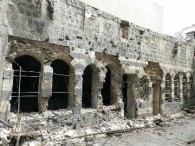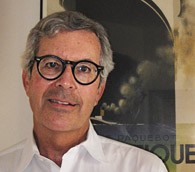Tag: Tourism
War-Torn Syria Courts Tourists. Really!
by Pam Mandel | 06.12.14 | 10:28 AM ET
Six sites in Syria are listed as World Heritage sites and 12 more have been nominated. The World Heritage Foundation lists Damascus as “the oldest capital of the world” and “the cradle of historical civilizations.” Descriptions of Syria’s other cultural wonders are equally lofty—Palmyra has been settled since prehistory, the minarets in Bosra are the oldest in the world. Little wonder travelers want to visit Syria. It’s a cultural crossroads rich in history, home to a spectacular array of archeological wonders. But there’s one minor issue with visiting the country: For about three years now, Syria has been in the grip of a devastating civil war.
This is no deterrent to the Syrian Ministry of Tourism (sorry, no link, their site sets off a virus warning). It launched a new campaign designed to convince travelers that Syria is a safe destination. The New Republic points out how Syria’s tourist sites have been affected by the conflict. For example:
In Homs, site of that fabled “prosperous tourist season,” Jabhat al-Nusra continues to carry out bombings that have left dozens dead. In Hama, the regime is encouraging tourism while it is allegedly using chemical weapons, especially chlorine gas
Homs was under siege by Bashar al-Assad’s government for nearly three years, The New Republic posits that a tourism campaign to the region is more about showing who’s in control than about improving the country’s devastated economy.
And this story on Fox describes the issues one might encounter when making a hotel reservation:
No one denies that logistics are difficult for holiday-makers. Hotel reservations, for example, can be iffy. The other day a band of foreign jihadists blew up Aleppo’s Carleton Citadel Hotel, drastically reducing the supply of five star accommodations in Syria’s fabled second city.
Difficult logistics indeed. The campaign overlooks the tragedy of nearly 10 million displaced Syrians. The cost of war on Syria’s precious historical sites is heartbreaking, but the toll on human lives is incalculable.
More than a decade ago, I was invited to tag along on a friend’s visit to Syria and I hesitated, nervous about my nationality, my gender, my religious upbringing. “Propaganda,” insisted my friend, “you’ll be fine.” The pro-tourism campaign is propaganda, too, of a very different kind. I prefer the other flavor. I might have needed a head scarf to show respect, but a flak jacket? Not so much so.
I deeply regret not going while I had the chance.
Travels Through the Wreckage of Japan’s ‘Triple Disaster’
by Michael Yessis | 09.02.11 | 7:59 AM ET
World Hum contributor Daisann McLane’s Well-Traveled dispatches about her travels to Sendai, Fukushima and Tokyo four months after the 9.0 earthquake, tsunami and nuclear disaster struck Japan has concluded at Slate. It’s an amazing series, powerful and heartbreaking and beautifully written. From the first of three parts, Sendai Rising From the Wreckage:
Even after four months, it’s a mess of Augean proportion: uprooted pine trees, splintered wood beams, crumpled abandoned cars, wooden fishing boats tipped on their side, trying to sail away on a sea of mud. Your first reaction is to throw up your hands in desperation—how on earth do you begin cleaning this up? But the Japanese have passed that shock stage, and have whipped themselves into action: a squadron of earth movers is busy, steadily organizing the endless wreckage into tidy haystack-like hills. “This was the town of Natori.” Akawa-san points over to a spot on the eastern, coastal side of the highway. There’s nothing there but a solitary house without walls, its soggy furnishings and books spilling out the way junk tumbles from an overstuffed closet.
McLane, whose extraordinary writing career has ranged from contributing to Rolling Stone during its heyday to her current spot as the Real Travel columnist for National Geographic Traveler, explained how writing about the triple disaster affected her in an email to friends and colleagues:
The experience overcame me. Those of you who are writers, photographers and editors will understand: Sometimes you find yourself in the middle of an extraordinary story that makes you want to write your heart out. This was one of them.
Tunisia Tackles Tourism Shortfall with Dark Humor
by Eva Holland | 07.14.11 | 5:49 PM ET
Tunisia’s role in the Arab Spring wasn’t as widely reported as, say, Egypt’s or Libya’s. But word about the country’s revolution has still spread far enough to cut tourism in half—and the Tunisian authorities are hoping to regain some of that lost revenue through a series of ads poking fun at the unrest.
According to the Guardian, one ad shows a woman enjoying a massage under the caption, “They say that in Tunisia some people receive heavy-handed treatment.” Another depicts an ancient archaeological site, with the tag line, “They say Tunisia is nothing but ruins.”
Tasteless? I suppose if I was a Tunisian civilian who’d been shot at or abused by police during the uprising, I might not be amused. But I think tackling a country’s reputation head-on is a good thing—and hey, as Australia learned a few years back, a little controversy can go a long way.
Confessions of a Travel Snob
by Amy Williams Bernstein | 02.22.11 | 10:41 AM ET
Amy Williams Bernstein considered herself an intrepid, independent traveler. Then she found herself at an all-inclusive Cancun resort.
The European Grand Tour, Chinese Style
by Eva Holland | 12.30.10 | 2:29 PM ET
The Economist takes note of a new variation on an old theme: a Chinese take on the classic “grand tour” of Europe. From the story:
China’s newly mobile middle classes like to visit established spots like the Eiffel Tower, the Louvre and Venice’s Grand Canal. But the visitors have also marked out a grand tour all of their own, shaped by China’s fast-developing consumer culture and by distinctive quirks of culture, history and politics. The result is jaw-dropping fame, back in China, for a list of places that some Europeans would struggle to pinpoint on a map: places like Trier, Metzingen, Verona, Luxembourg, Lucerne and the Swiss Alp known as Mount Titlis.
(Via @reidontravel)
World Travel Watch: Hundreds Killed in Phnom Penh Stampede, Dutch ‘Coffee Shops’ Closing to Tourists
by Larry Habegger | 11.24.10 | 12:03 PM ET
Larry Habegger rounds up global travel news
World Travel Watch: Tube Strike in London, Election Worries in Egypt and More
by Larry Habegger | 11.17.10 | 1:26 PM ET
Larry Habegger rounds up global travel news
World Travel Watch: Traffic Restrictions in Italy, Conflict on the Thai-Burmese Border and More
by Larry Habegger | 11.10.10 | 1:29 PM ET
Larry Habegger rounds up global travel news
Tour Guide Battle in Southern California Leaves Chinese ‘Very Afraid’
by Michael Yessis | 11.10.10 | 1:02 PM ET
Chinese tourists are increasingly bringing their own guides when they travel to Southern California. Local guides are pissed about losing business and, allegedly, becoming confrontational. The Los Angeles Times breaks it down:
Wang Suqi, president of Beijing-based Total Travel International Travel Service, claims that one of his tour leaders was punched by an American tour guide at Universal Studios Hollywood, and now his tour leaders have asked to be transferred to different tours in Europe and Southeast Asia.
“They’re very afraid,” Wang said. “Even our customers are asking what’s going on.”
The competition for the Chinese tourism business was set off in 2007 when China, for the first time, allowed commercial travel agents to book group pleasure trips to the U.S. But China did not mandate that Chinese tourists hire accredited American tour guides—a requirement that China imposed on other countries, including Vietnam, Cambodia and Thailand.
Of course, it’s mostly about money. Chinese travelers have been unleashed in recent years, and they spend.
In 2009, Chinese travelers spent an average of $6,800 per person per visit, including airfare, according to the U.S. Commerce Department. By 2020, China will become the world’s fourth-largest source of tourists, the United Nation’s World Tourism Organization predicts.
‘They Like Shopping, Theme Parks and, of Course, Eating’
by Eva Holland | 11.04.10 | 1:01 PM ET
That’s according to a tourism real estate investor keen to anticipate the needs of a growing wave of Chinese tourists. The Independent reports on the ways some tourism operators are preparing for that wave—here are the numbers motivating the effort:
Travelling Chinese spent US$43.7 billion (31 billion euro) on tourism in 2009 - a rise of 21 per cent year on year. And the United Nation’s World Tourism Organisation says it is only a matter of time before they spend more than visitors from the traditional international travel leaders Germany, the United States and the United Kingdom.
Outbound trips by Chinese are meanwhile expected to jump from an estimated 52 million this year to 100 million in 2020.
BP to Spend Millions on Louisiana Tourism Promotion
by Jim Benning | 11.02.10 | 5:12 PM ET
The funds, totaling $78 million, will also help promote the Louisiana seafood industry.
According to Business Week:
BP has paid out $87 million to Gulf Coast states for tourism promotion, and has so far committed to an additional $30 million to Louisiana. The company has also promised $68 million to Louisiana and Florida for seafood testing and product marketing.
I wonder whether any of that money will help fund travel-writer junkets to the region. As we noted in September, some BP money already has, prompting a debate about the ethics of a such a trip.
Spiritual Tourism Struggling in Sedona
by Eva Holland | 10.22.10 | 12:39 PM ET
The New York Times’ Mark Lacey reports from Sedona—“Arizona’s New Age mecca,” as World Hum contributor Laurie Gough calls it—where visitors numbers are way down. Here’s Lacey:
Nobody is sure exactly what is keeping people away from Sedona’s four vortexes, swirling energy sources emanating from the earth, but the effects are clear: far fewer crystals are being bought, spiritual tours taken and treatments ordered, from aura cleansings to chakra balancings.
That an earthly power—the economy—is a culprit is not in doubt. But some do not discount the effects of an awful incident from a year ago that put Sedona’s New Age community in a bad light and that, to some degree, still lingers, despite efforts by metaphysical people to cast it away.
The rest of the story delves into the impact of that incident last year, when three tourists died in a sweat lodge ceremony. It’s a chilling read.
A Tintin Tour of Jordan
by Eva Holland | 10.21.10 | 12:23 PM ET
The Guardian’s Georgia Brown made an unconventional trip to Petra—guided by a “Tintinologist” and a copy of The Red Sea Sharks. We’ve talked before about Tintin’s appeal to travelers, and in her dispatch Brown’s guide notes another aspect of that appeal:
Thousands of tourists visit Petra every week, but this summer I was part of the first small group of adventurers to arrive at the rose-red city in the footsteps of Tintin, led by one of the world’s leading Tintinologists, Michael Farr.
For Michael—who, dressed in beige linen suit and explorer’s hat, looks to have stepped from that golden era of travel—this is clearly part of the delight. A natural raconteur, he explains that Tintin creator Hergé’s drawings were astonishingly accurate, from his rendering of landscapes such as the Middle Eastern desert and local costumes, down to the accuracy of Egyptian hieroglyphs painted on a tomb or the Chinese lettering on a street banner. When fans of the comics see images of the real thing they perhaps cannot help but be reminded of the books in which they first saw them.
(Via The Book Bench)
Tourism Promotion Through ... Food Trucks?
by Eva Holland | 10.20.10 | 1:10 PM ET
The Wall Street Journal notes a potential new trend: Foreign tourism boards stirring up interest abroad by offering free food-truck meals to entice potential visitors. Here’s reporter Sumathi Reddy:
Foreign countries are increasingly hoping food is the key to New Yorkers’ hearts—and purse strings. In June, the Bahamas Ministry of Tourism had a Treats & Tweets truck dishing out free Junkanoo drumsticks (chicken wings), Bahamian macaroni and cheese and virgin Bahama Mamas for a week. “It was promoting tourism and travel to the Bahamas using food as a conduit,” said Chelsey Lutz, a spokeswoman for the ministry.
This is one form of promotion I can definitely get behind. (Via @collazoprojects)
World Travel Watch: Protests in France Turn Violent, Entry Fee in Venice and More
by Larry Habegger | 10.20.10 | 12:56 PM ET
Larry Habegger rounds up global travel news
A Short History of Touring Dead Writers’ Houses
by Eva Holland | 10.18.10 | 4:44 PM ET
In the New York Times, Anne Trubek dissects the phenomenon, which has a longer history than you might expect—apparently, visitors were already making their way to Petrarch’s birthplace in the 1300s. But most writer’s-house visitors aren’t there for the sake of literature. Here’s Trubek on the motivations behind many visits:
According to curator and tour-guide estimates, only about half of the 2,000 people who visit the Walt Whitman House in Camden, N.J., each year come because they are interested in Whitman (as opposed to a nice historical stopover after touring the battleship down the road). Just 10 percent of the 9,000 annual visitors to the Thomas Wolfe Memorial in Asheville, N.C., come specifically for the author. Most people who visit the Mount, Edith Wharton’s lavish estate in tourist-friendly Lenox, Mass., are killing time before a concert at Tanglewood (and tend not to continue to Arrowhead, Herman Melville’s modest homestead in the nearby depressed industrial city of Pittsfield). Half of the 182,000 annual visitors to Hemingway’s house in Key West say they come for the cats.
(Via The Book Bench)
Let Us Now Praise Tour Guides
by Tom Swick | 10.18.10 | 2:29 PM ET
Here's to the men and women willing to go off script
Could Chile See a Tourism Bump Thanks to its Rescued Miners?
by Eva Holland | 10.18.10 | 11:52 AM ET
Arthur Frommer thinks so. CNN’s Business 360 blogger agrees:
It would be difficult to put a price on how much the good news exposure will be a boost to Chilean business abroad, tourism at home or even the numbers who will choose a Chilean red over an Australian or French vintage on their way home tonight.
USA Today’s Laura Bly notes that an underground museum may be in the works at the rescue site.
World Travel Watch: Penalties for Touts in Delhi, Tourist Tax in Lisbon and More
by Larry Habegger | 10.06.10 | 2:36 PM ET
Larry Habegger rounds up global travel news
A Tourist Goes to Church in Harlem
by Eva Holland | 09.27.10 | 2:50 PM ET
Slate writer Jeremy Stahl set aside his discomfort “at the prospect of joining other underdressed white gawkers observing how ‘locals’ pray” and headed north of 96th St. in Manhattan on a Sunday morning. The resulting dispatch is a thought-provoking read. Here’s Stahl setting the scene at Greater Highway Deliverance Temple:
When the music started, the usher who had greeted us began dancing up and down the aisle. The congregation stood up and started to clap and sway. One tourist pantomimed the drumming and imitated the dancing in what looked like an attempt to impress two female friends. The choir performed “I Came To Praise the Lord,” and the lyrics—“I don’t know what you came to do, I came to kneel and pray”—stung almost like a collective rebuke. At one point, a church leader declared the “visitor” count for the day’s service at 147, listed the represented countries, and told us “thank God for each and every one of you”—even, I suppose, the dozing Japanese woman to my left.
When we were back on the bus, our tour guide, Sheila, asked if anyone had any questions. There was just one: “They weren’t offended?”
- « Prev Page
- Next Page »



